This post may contain affiliate links. By clicking and making a purchase through the links, I earn a small commission at no extra cost to you. See my disclaimer for more information. This and display ads allow me to keep the site up to date and give back.
If you’re thinking of diving in Fiji for the first time, this guide is for you.
Whether you want to drift through the soft corals or get your adrenaline rush diving among bull sharks and hammerheads, Fiji’s dive sites can offer it.
With over 300 Fiji islands scattered throughout the South Pacific Ocean, you’re probably wondering where the best places to dive in Fiji are. It was overwhelming planning my dive trip to Fiji!
In this guide, I’ll walk you through the top dive sites in Fiji, as well as suggestions on the best dive resorts to stay in.
Best places to go diving in Viti Levu, Fiji
Viti Levu is one of the big islands in Fiji, which is home to Nadi. As this is where international flights land, it’s a great place to start your dive adventure in Fiji.
Beqa Shark Dive (Viti Levu)
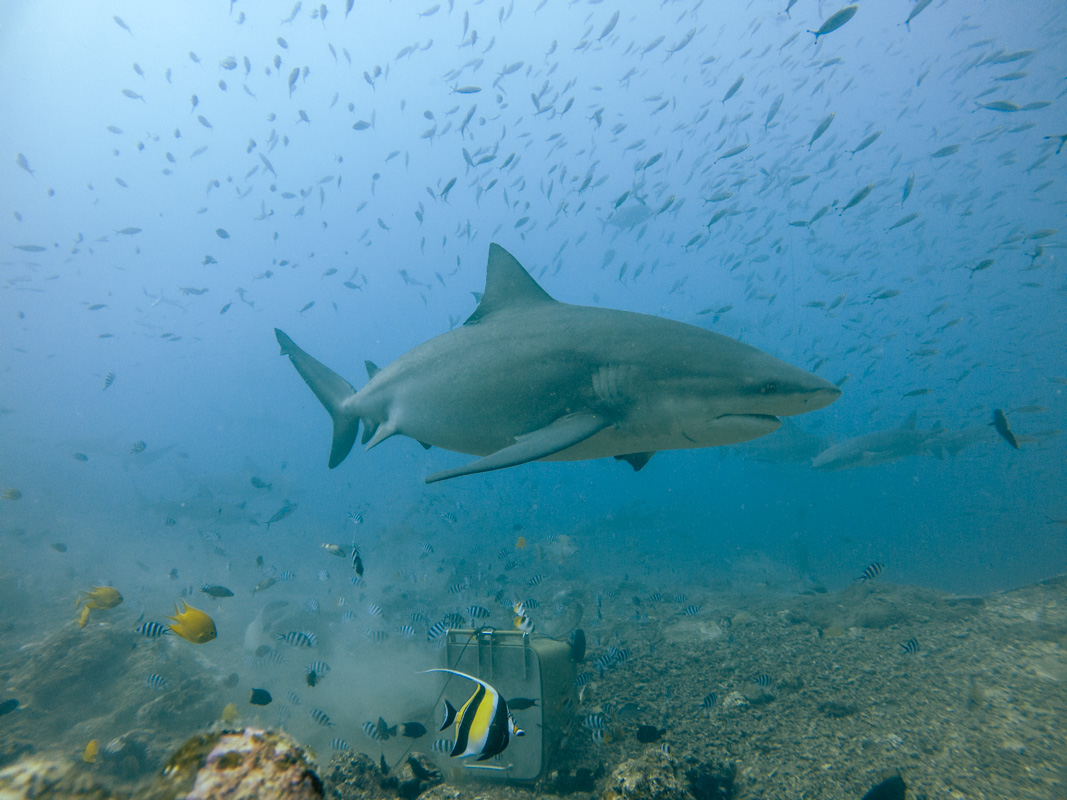
If you love shark dives, then make the Beqa lagoon your top choice for diving in Fiji.
The Beqa Lagoon has multiple reefs where sharks live that have been declared Marine Protected Areas by the government.
You can see up to seven different species of sharks, including bull sharks, whitetip and blacktip reef sharks, nurse sharks, lemon sharks, grey reef sharks, silvertip sharks, and, if you’re lucky – tiger sharks.
And no, it’s not a cage dive. You’ll be just a few feet away from the sharks! While mildly terrifying, this is easily one of the most exciting dives I’ve done in my life.
Who to go shark diving with
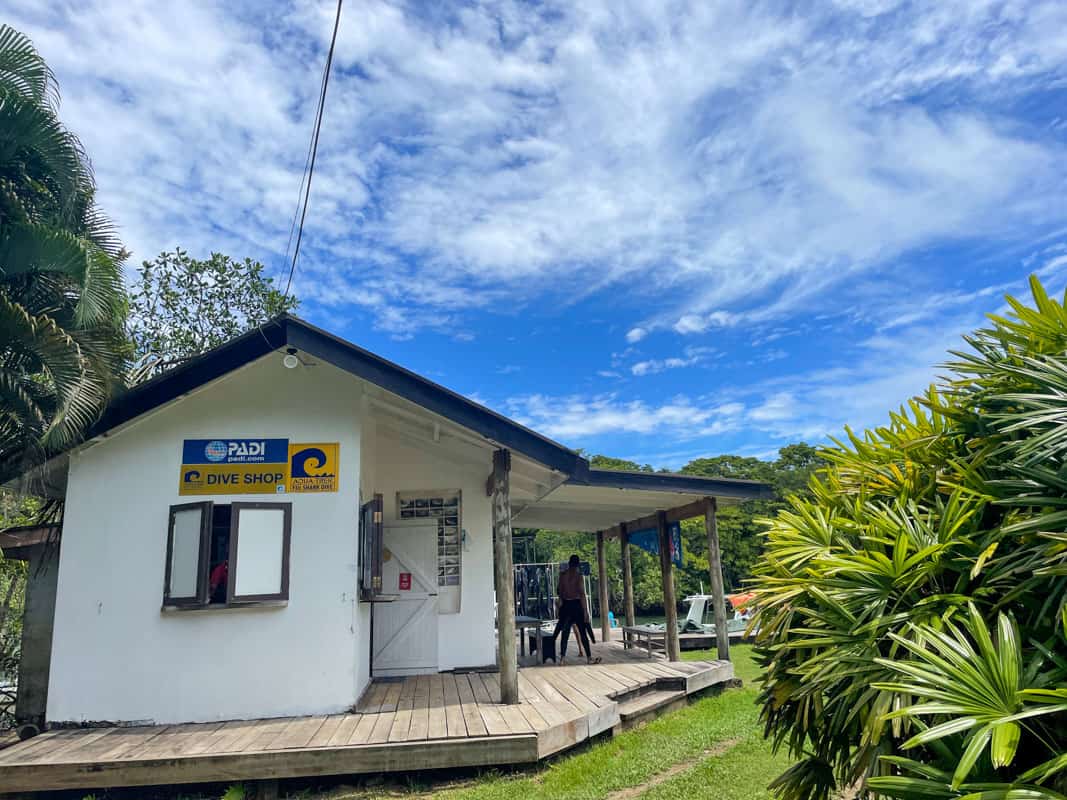
I dived with Aqua-Trek, who pioneered shark diving in Fiji over 33 years ago.
What I love about Aqua-Trek is that they are a responsible dive operator actively working on shark conservation in the area.
They have created the Aqua-Trek Fiji Shark Conservation and Sustainable Tourism Program, which works closely with the Fijian government and local villages to help protect reefs within the Beqa Lagoon. They are also actively campaigning to ban shark finning and the sale of shark products in Fiji.
As part of your fee to dive, you’ll pay a levy that goes directly to the local village of Wainiyabia to help with village education programs and community improvement.
How does the dive work?
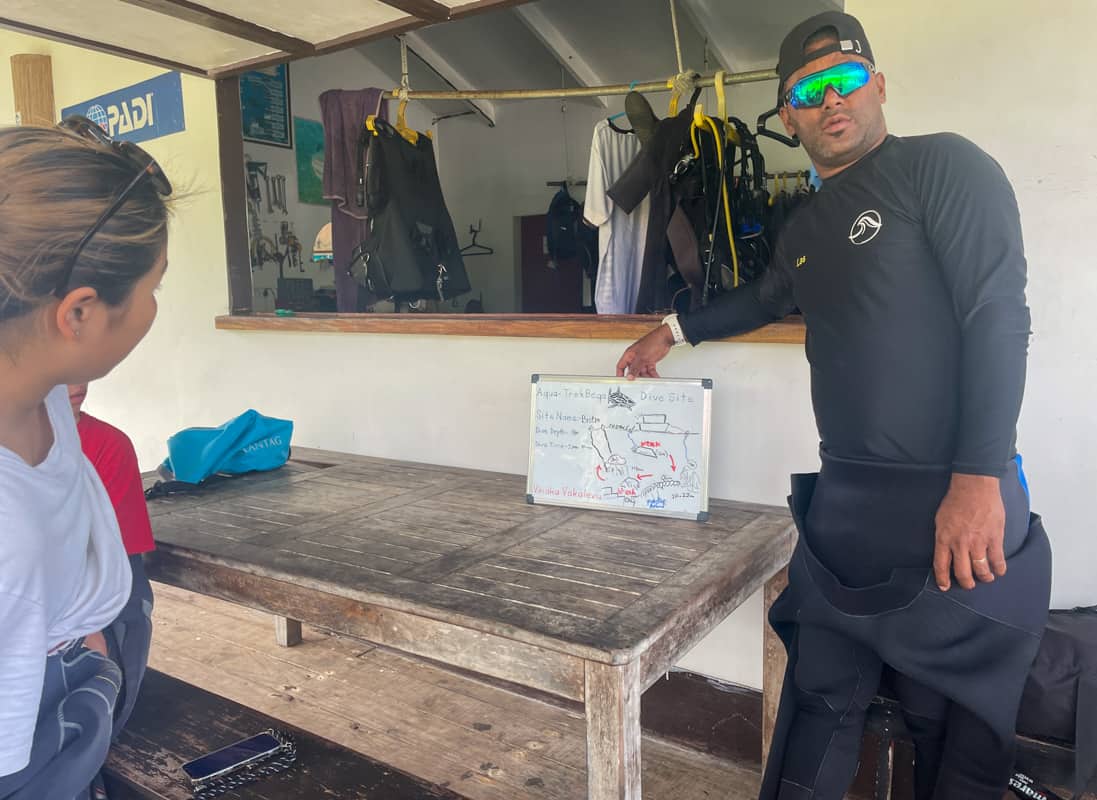
After being picked up from my hotel in Pacific Harbour, we arrived at the Aqua-Trek dive shop and got fitted into our dive gear. The dive master gave us a briefing on the dive, and we headed out on the dive boat to the lagoon.
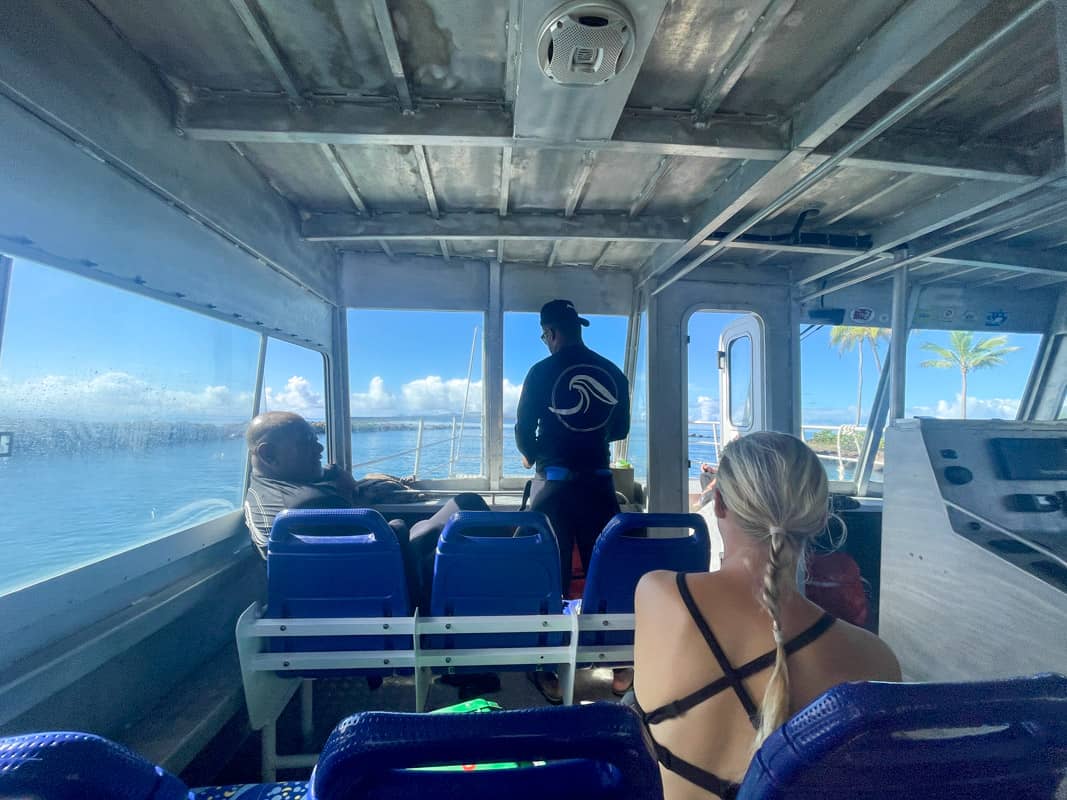
After about 25 minutes, we arrived at Bistro dive site (maximum depth 18m), where both dives take place.
The dive masters go down first with a large container of fish, which attracts the sharks.
You’ll be on the perimeter of the dive site called “The Arena.” Once settled in, the feed begins. The viewpoint is insane; the sharks are just a few feet away from you.
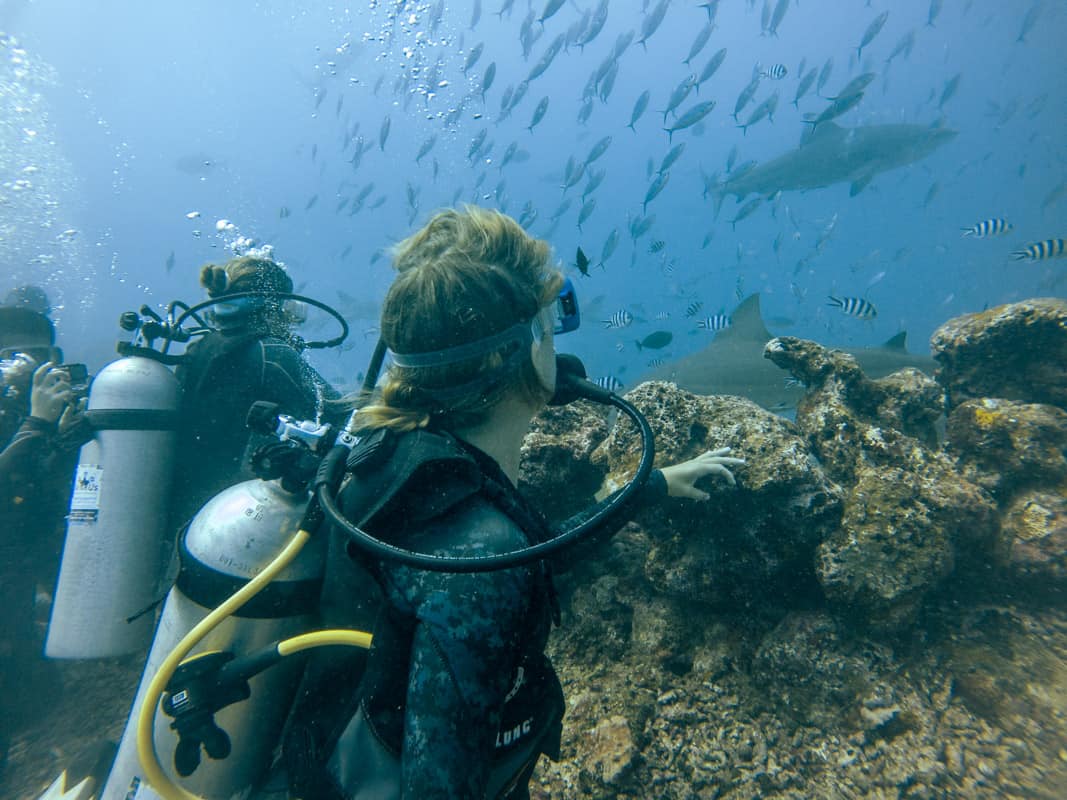
It was mildly terrifying seeing them come towards me as we descended into the dive site, but after a few minutes, I adjusted and was mesmerized watching the sharks feed.
After about 35 minutes, we came back up to the boat for a surface interval, where cookies and coffee were served. Then, it’s back down for the second dive.
While you visit the same site, it’s not an experience you get sick of seeing; the second time was equally exciting.
On the way back from the dive, we quickly went through a coral reef, but the currents were quite strong. Due to the conditions, it’s best to be an experienced diver for this dive.
Overall, it was a bucket list moment for me and my most memorable dive in Fiji.
Getting to Pacific Harbour
The dive trip takes place from Pacific Harbour, which is on the east coast of the main island of Vitu Levu.
The closest airport is Suva-Nausori Airport, which I flew into from Vanua Levu. If you’re coming internationally, you’ll be flying into the Nadi International Airport.
Regional flights with Fiji Airways are affordable if booked in advance (I paid 50 USD for mine. They are small tiny plans that offer a scenic, unique experience.
From Suva airport, it’s an hour’s drive to Pacific Harbour. From Nadi, it’s 2 1/2 hours.
There are public buses you can take from either city. I got a private taxi for 100 FJD from the Suva airport, or you can arrange a private transfer in advance.
Where to stay in Pacific Harbour
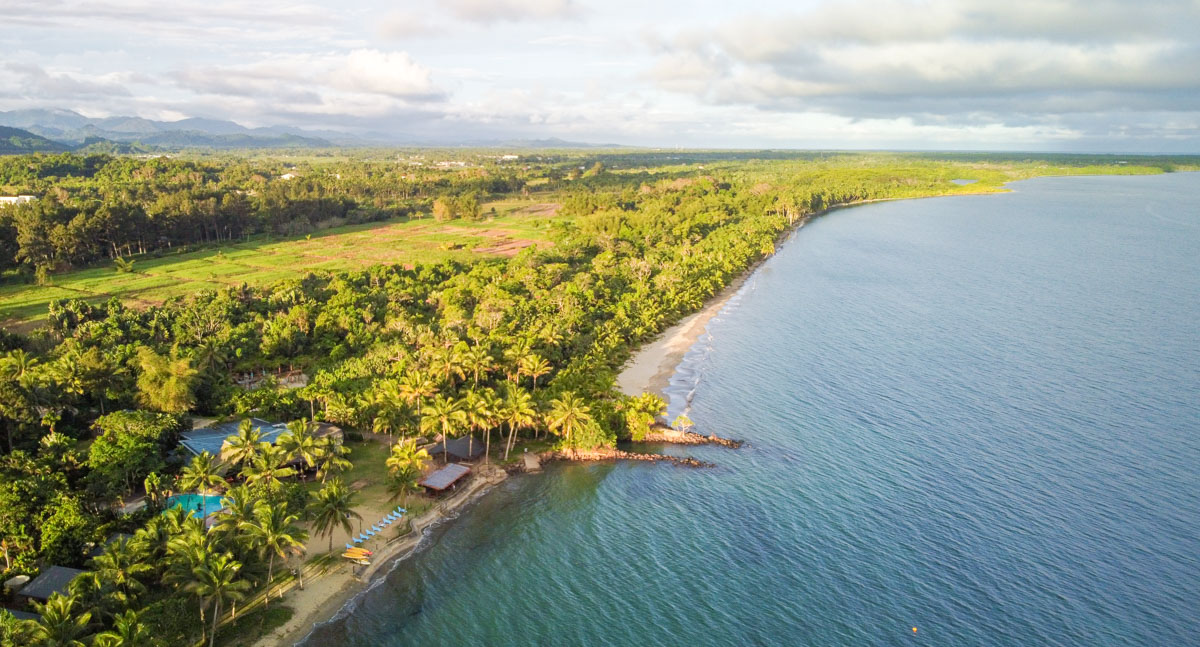
There are a variety of accommodations in Pacific Harbour to choose from, depending on your budget and preferences.
I stayed at Uprising Beach Resort, which was a wonderful experience. It’s a good place for solo travelers in Fiji, as they offer dormitory rooms as well as private bures.
I stayed in a beachfront bure which was so spacious and comfortable. At the resort, they also have activities regularly, and you can take kayaks out to explore. The staff are friendly, and there’s a great on-site restaurant. You can see more about what it was like staying in this video below!
@explorewithlora Location at end 🥰 Loved this Fiji resort! Its also good for solo travelers in Fiji as they have a treehouse dormitory for 28 USD a night. 😊 #fijiresorts #visitfiji #pacificharbour #lovefiji #travelfiji ♬ Aesthetic Girl – Yusei
Another great option right next to Aqua-Trek is Pearl South Pacific Resort. This luxury resort is right on the beach and offers an outdoor swimming pool, swim-up pool bar, six fully licensed restaurants and bars, a fully equipped gym, a waterside spa, and an 18-hole championship golf course.
Other things to do in Pacific Harbour
Pacific Harbour is known as the adventure capital of Fiji, so if you come for the dive, stay for a few days and explore the area.
I joined this combo-adventure tour which took us on a boat trip/tubing down the river to a local village and exploring stunning waterfalls. It was such a fun day!
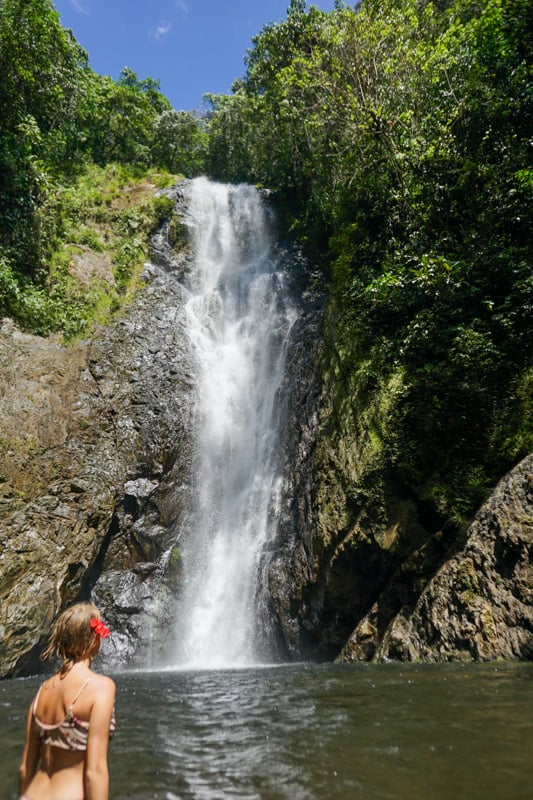
You can also go ziplining in Pacific Harbour.
Mamanuca Islands (West of Vitu Levu)
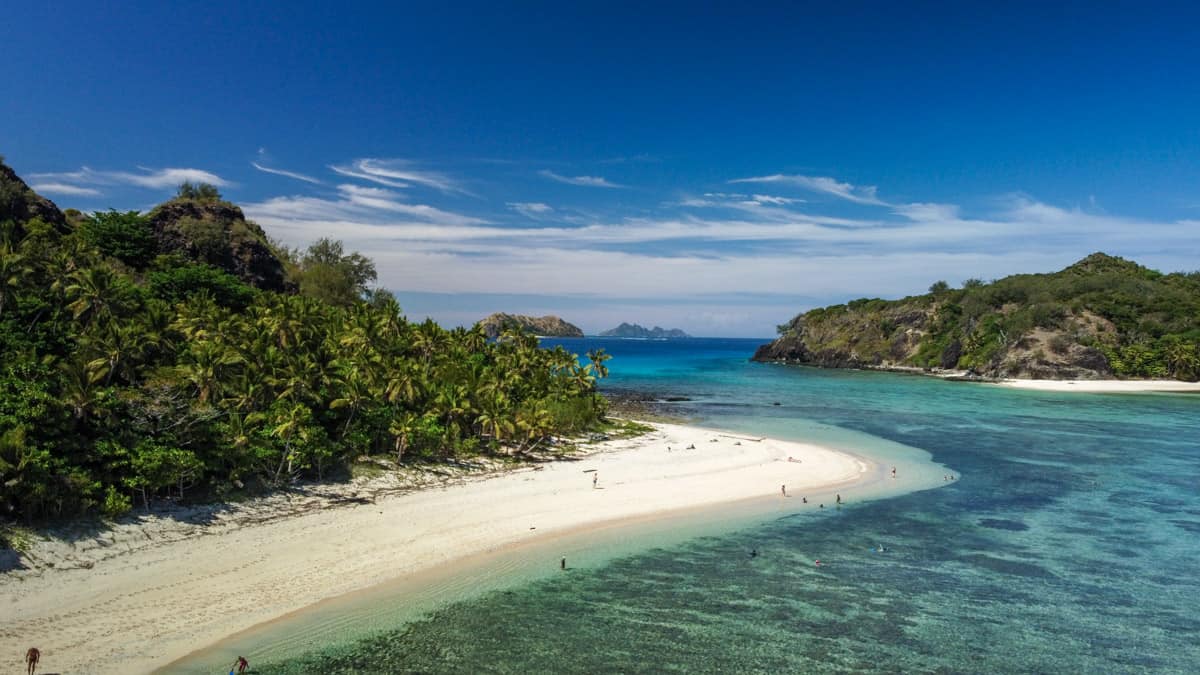
The Mamanuca Islands are a collection of small islands just west of Nadi, so you can either visit on a day trip, live aboard, or small ship cruise.
This is a great place to see soft corals, which Fiji has no shortage of. In fact, Jacques Cousteau named the country ‘the Soft Coral Capital of the World.’
I joined a 3-day small ship cruise with Captain Cook through the Mamanuca Islands, which had a dive center on the boat.
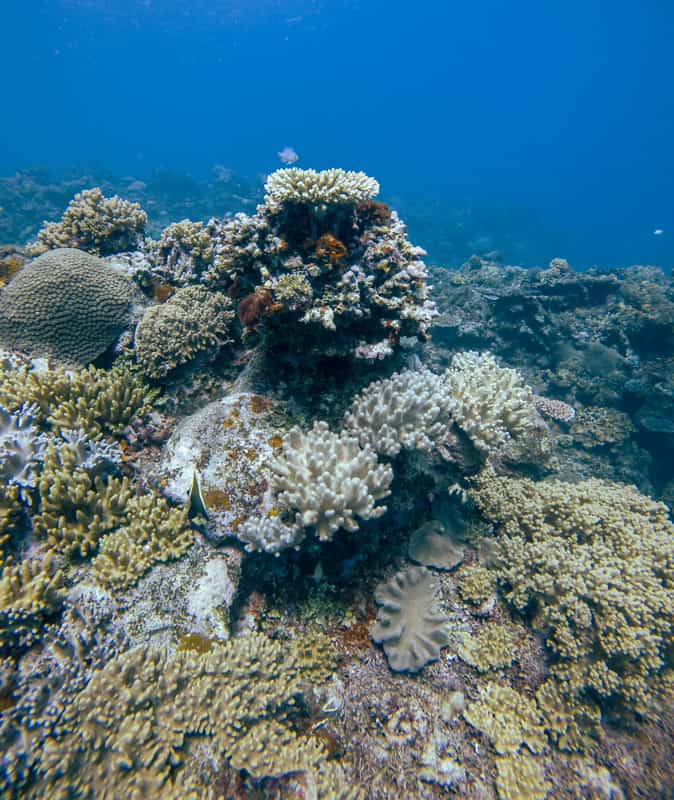
As we visited several remote coral reefs, it was an amazing opportunity to explore some of Fiji’s best reefs.
The general rule is that the more remote the islands, the better the visibility and diversity of flora and fauna, so a small ship cruise is a great way to explore Fiji’s underwater world.
Manta Ray Island (Northwest of Vitu Levu)
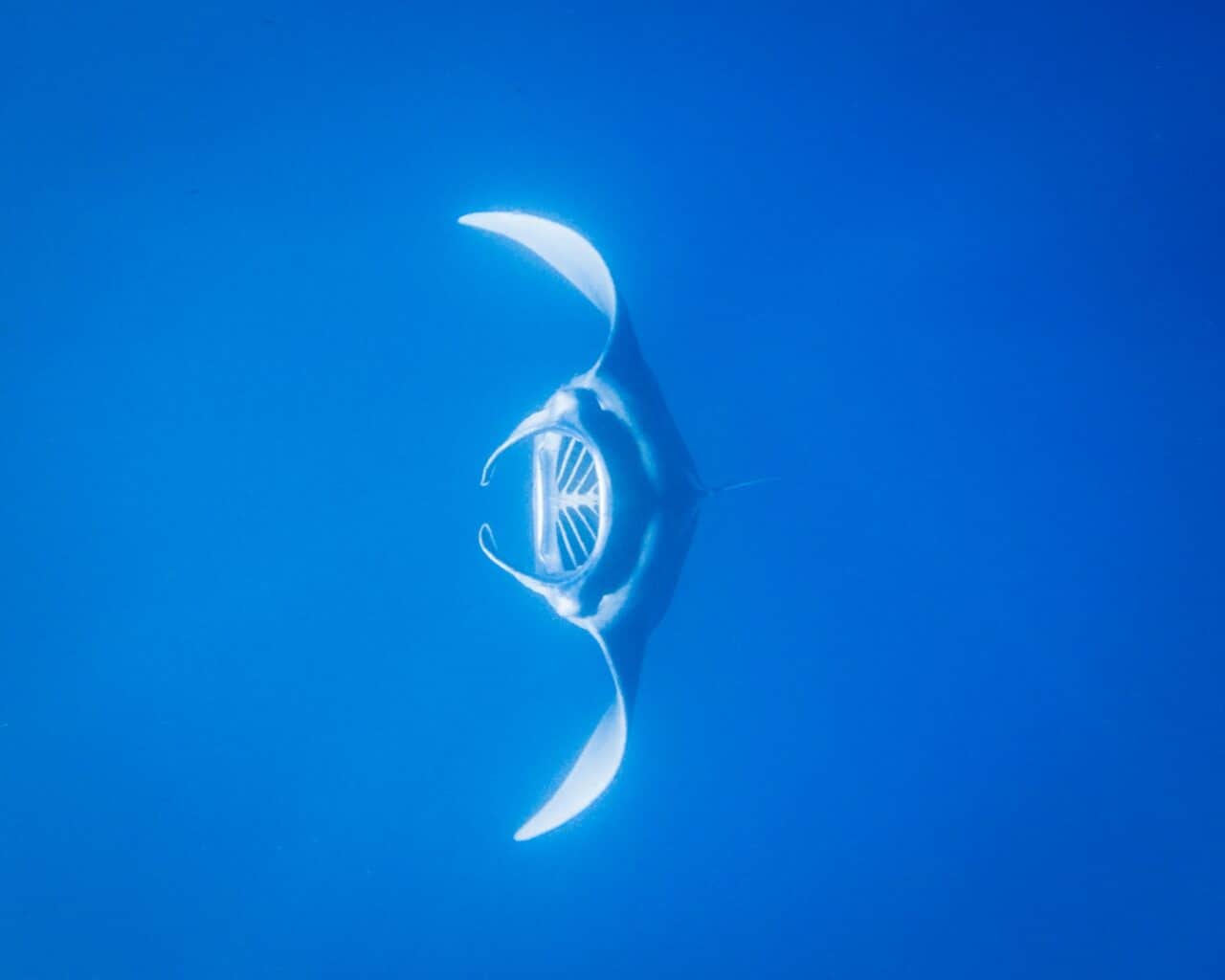
If you want to go diving with mantas, head to Manta Island in the Yasawa Islands. The best time to visit is from April to September when hundreds of mantas come to feed on the nutrient-rich waters full of plankton blooms.
Suggested resort: Barefoot Manta has over 40 dive sites surrounding it. There are swim-throughs, caves, coral gardens, pinnacles, as well as night dives.
Great Astrolabe Reef (Kadavu Island, South of Viti Levu)
Kadavu Island is the gateway to the Astrolabe Reef, which is one of the largest barrier reefs in the world after Australia and Belize.
It’s a remote and pristine area where you can see abundant coral and marine life. Common sightings include big fish like marlin, tuna, as well as various shark species. It’s one of the least commercialized dive sites in Fiji, so this is a good place to go if you want to connect with nature.
Best dive sites on Vanua Levu
Namena Marine Reserve (Namena Island, South of Vanua Levu)
The Namena marine reserve is widely considered the best place to dive in Fiji.
It’s one of the most biodiverse places in the area, with over 1000 tropical fish species and 400 coral varieties. You can see huge soft corals, as well as massive schools of barracuda, jacks, sharks, and hammerheads if you’re lucky!
There’s also a good chance at seeing some big marine animals in this reserve. Hammerheads in the winter, dolphins in the summer, and humpback whales from July to October.
Suggested resort to visit: Namena Island Resort.
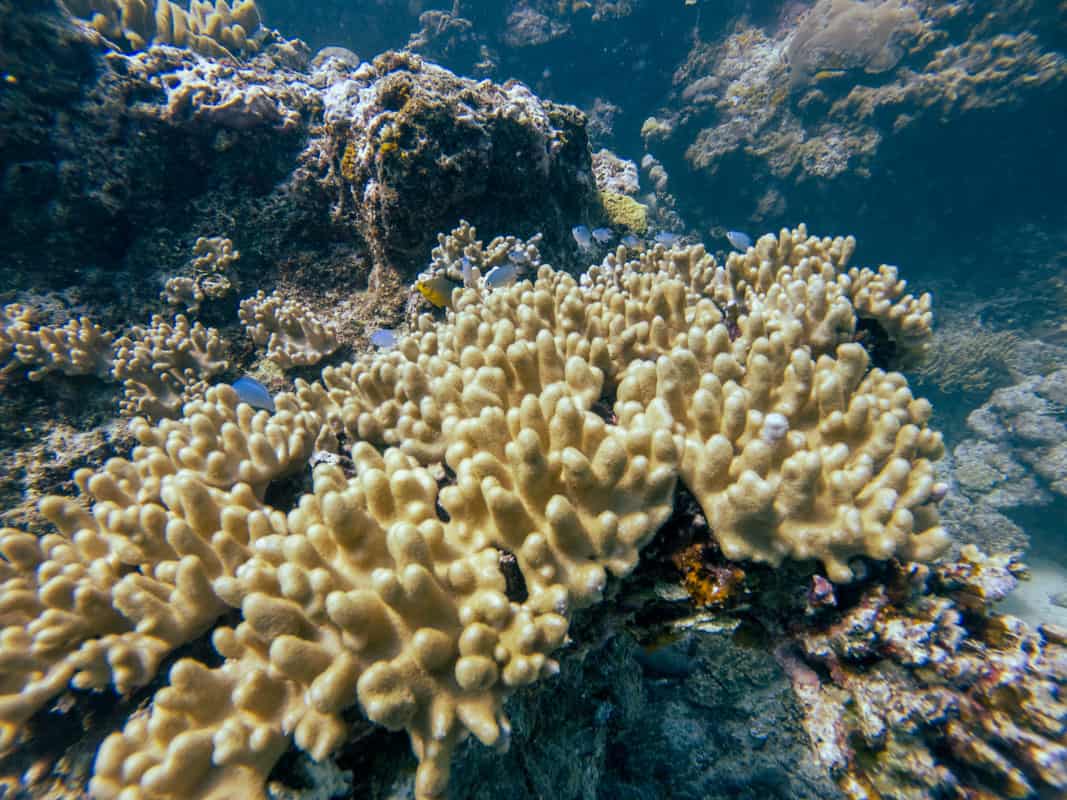
Taveuni Island (Southeast of Vanua Levu)
Taveuni Island is the gateway to the world-famous Rainbow Reef, which has over 20 colorful dive sites to explore.
The inner reef is known for its soft coral species, while the outdoor reef is where you can try your luck at shark encounters. Whitetips, gray reef sharks, and nurse sharks are known to be in the area!
Unfortunately, I didn’t have time to visit Rainbow Reef, but it’s high on my list for the next time I’m back in Fiji.
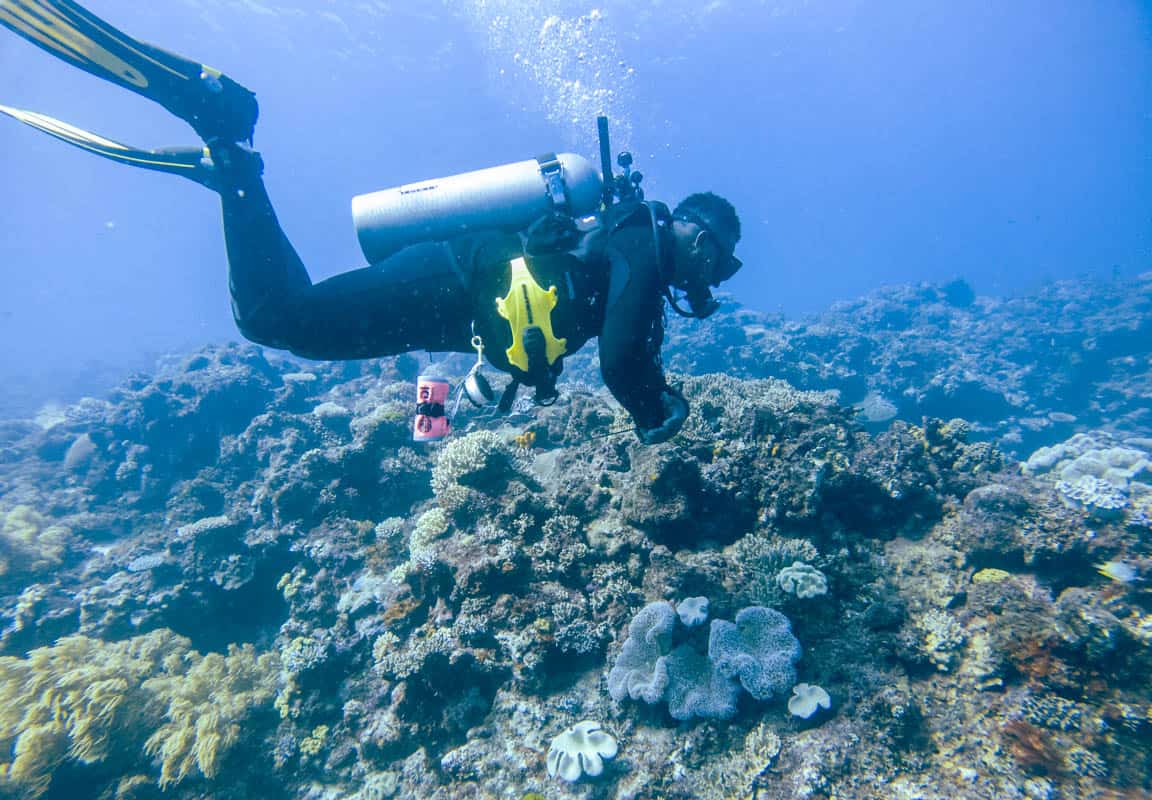
The Great White Wall in the Somosomo Strait is one of the most popular dives here.
The wall is covered with some of the most colorful soft and hard corals, species of fish, and unique marine life that you’ll find in Fiji. It’s typically done as a drift drive, so you can just relax and enjoy the scenery.
Suggested Resort: Taveuni Dive Resort is a sustainable dive resort designed by scuba divers for divers.
Koro Sun Resort
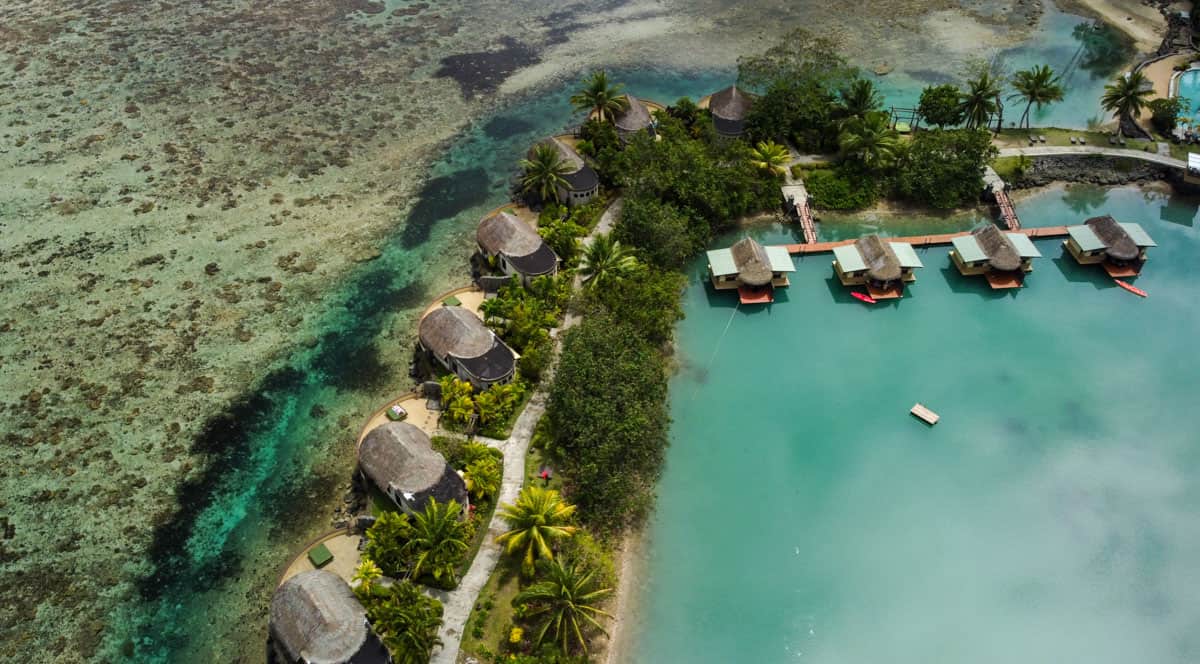
Some of the best scuba diving in Vanua Levu is from Koro Sun Resort. I spent three nights at this beautiful property, which has a dive center onsite. You can read my full Koro Sun Review here.
There are several world-class dive sites just a 5-minute boat ride from the resort, making this a perfect place for a dive holiday. If you aren’t a certified diver, the center does open water and advanced PADI courses and discovery dives.
You can even see hammerhead sharks at one of the dive sites (it’s about a 50% chance).
On my dive from Koro Sun at turtle alley, we saw white-tip reef sharks, turtles, and gorgeous soft corals.
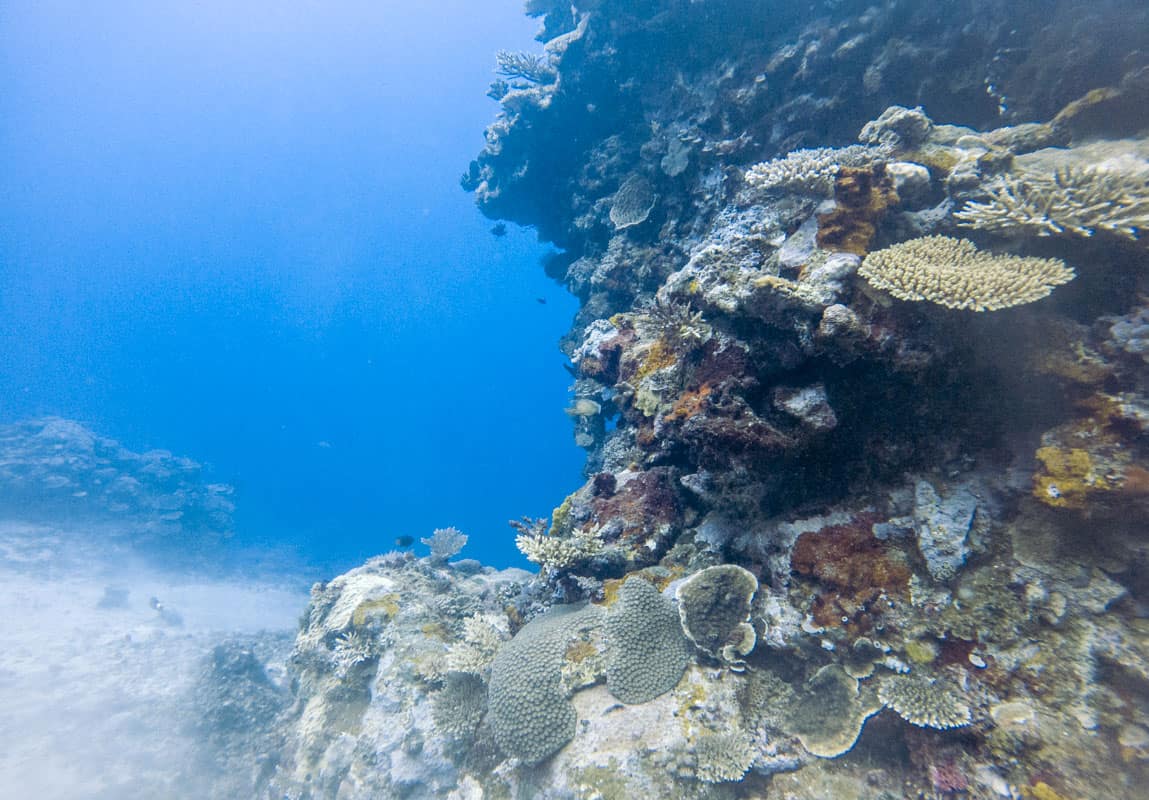
The dive center does make trips to Namena marine reserve, but as it’s a long boat ride away, they require a minimum of six people and good weather conditions. I was disappointed that I couldn’t go there, so make sure to plan in advance if you want to visit this reserve.
Fiji dive liveaboards
As the more remote dive sites offer the best visibility, the best way to explore Fiji’s abundance of dive sites is on a liveaboard.

When is the best time to go diving in Fiji?
Fiji has a warm tropical climate between 28-30c year round, with a comfortable water temperature between 23-27c.
You can dive in Fiji year-round, but for the best visibility, you’ll want to dive between July and December. I visited in September, and the visibility was excellent.
The cyclone season goes from November to March when there is an increased chance of swells and strong currents, which could interrupt your dive plans. That said, these conditions also bring the chance to see larger marine animals.
—
Fiji is one of the world’s top dive destinations. It was a dream of mine to dive here for some time, and it lived up to my expectations!
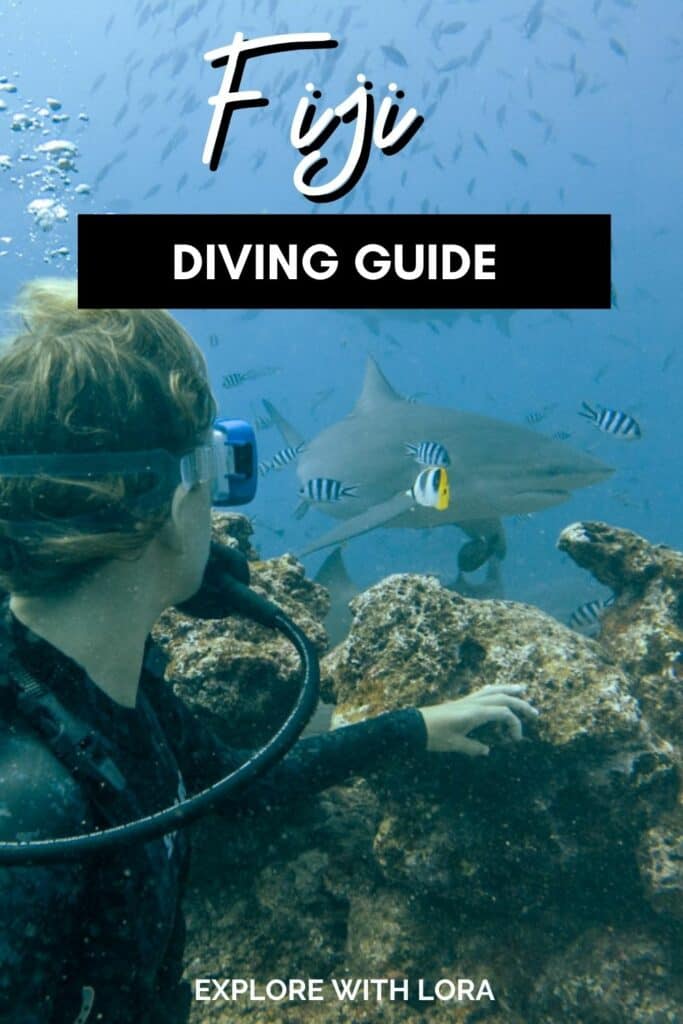

Leave a comment